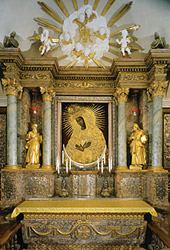Chapel of the Gate of Dawn
The chapel dedicated to the Mother of God is situated inside a 16th century defensive tower known as the Gate of Dawn. This two-story building, with a floor plan that is nearly square, acquired architectural traits of the late classicist style during works carried out in 1829. Its two-tier façade, reminiscent of a triumphal arch, has a triangular pediment on which is depicted the Eye of Providence, a sign of divine protection. The pediment bears two Latin inscriptions: Mater Misericordiae (“Mother of Mercy”), and below, Sub tuum praesidium confugimus (“we take refuge in thee”). The inscriptions were originally in Polish, but following a popular revolt in 1863, the Tsarist authorities required that they be replaced by the Latin texts. The Polish inscriptions were restored in 1933, though today we once again see them in Latin – the language of the universal Church.
The miraculous image of the Mother of Mercy is at the centre of a classicist altar. On either side of the painting, between columns, stand sculptures of Mary’s parents, Sts Joachim and Anne. The ceiling vaults are decorated with thin plaster reliefs depicting a star and two other Marian symbols taken from the popular Litany of Loreto: to the left, facing the altar, the “Ark of the Covenant”, the Old Testament sign of God’s continual presence among his people; and to the right, the “House of Gold”, the dwelling of God’s wisdom, crowned with a vine branch and a reed. The lower walls of the chapel are covered by an art deco frieze in pressed metal made in 1932 in Vilnius. The frieze contains stylized lily branches whose blossoms are medallions with reliefs depicting the invocations from the Litany of Loreto. It is a visual echo of the litany which pilgrims intone here every day. The silver used for the frieze is from the abundant votive offerings which thankful pilgrims have left at the chapel over the years, and which also cover its walls. The votive offerings, of which there were 1,438 when counted in 1856, tripled in number by 1927, when the chapel was redecorated in preparation for the coronation of Our Lady’s image.








